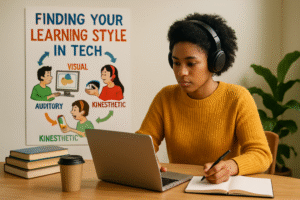
Peer review as a learning tool
In a world where knowledge evolves at a breathtaking pace, the ability to learn effectively has become a competitive advantage. Among the array of learning strategies, peer review stands out—not just as an academic requirement but as a dynamic tool for growth, reflection, and genuine skill development. This is especially true in technology, where collaboration and lifelong learning are essential. For women in tech, neurodivergent learners, and anyone navigating the complex terrain of modern education, peer review can be a bridge to deeper understanding and confidence.
What Is Peer Review? A Fresh Perspective
At its core, peer review is the process by which learners evaluate each other’s work. Traditionally associated with scholarly publishing, in contemporary education and IT workplaces, it has evolved into a powerful feedback mechanism. It encourages critical thinking, nurtures empathy, and hones communication skills. When learners assess each other’s code, essays, or project drafts, they are not only supporting their peers—they are reinforcing their own understanding.
“Peer review is not simply about finding flaws. It’s about cultivating a community where feedback becomes the engine of improvement.”
Peer Review in Action: Beyond Academia
In technology, peer review takes many forms. In open-source projects, code reviews are the backbone of quality assurance and mentorship. In bootcamps, learners swap project assessments, offering constructive criticism. For women in tech—often underrepresented in feedback loops—peer review can foster a sense of belonging and agency. And for neurodivergent learners, it’s an opportunity to communicate in structured, predictable ways that play to their strengths.
Why Peer Review Works: The Cognitive Science
Research consistently demonstrates the benefits of peer review in learning. When we explain concepts or critique others’ work, we engage in elaborative retrieval—a process proven to strengthen memory and understanding. By articulating feedback, learners crystallize their own knowledge. Moreover, reviewing diverse approaches exposes learners to alternative strategies and perspectives, enriching their own toolkit. This is especially valuable in IT, where there is rarely a single correct answer.
For neurodivergent learners, peer review can scaffold executive functions like planning, attention, and self-regulation. Structured feedback rubrics, clear expectations, and predictable timelines can transform the review process into a supportive scaffold rather than a source of anxiety.
Actionable Example: Peer Code Review in a Bootcamp
Consider a scenario: a group of learners in a web development bootcamp. After completing a module on JavaScript, each student submits a project. Instead of only receiving instructor feedback, each student is assigned two peers to review. They use a rubric with criteria like readability, efficiency, and creativity.
As a reviewer, you might notice an elegant way a peer has handled user input or spot a security vulnerability you hadn’t considered in your own work. As a recipient, you gain targeted insights and, crucially, learn to differentiate between subjective preferences and objective best practices.
Building Effective Peer Review: Tips for Success
While peer review is powerful, it is not automatically effective. The difference lies in structure, culture, and intentionality. Here are key strategies to unlock its full potential:
1. Set Clear Expectations
Define what quality feedback looks like. Use rubrics or checklists that break down the criteria for success—whether for an essay, a code snippet, or a project presentation. For neurodivergent learners, clarity and predictability are especially important; knowing what’s expected can reduce anxiety and increase participation.
2. Model Constructive Feedback
Not everyone instinctively knows how to give feedback that is both honest and kind. Model the use of “I noticed…” and “You might try…” statements. Encourage reviewers to highlight strengths before suggesting improvements. Emphasize specificity over generality: “The way you organized your functions improved readability” is more helpful than “Good job.”
“Feedback is most powerful when it is actionable, respectful, and rooted in a shared commitment to growth.”
3. Foster a Safe, Inclusive Environment
Psychological safety is the bedrock of effective peer review. Make it explicit that mistakes are learning opportunities, not evidence of incompetence. Celebrate diverse approaches and encourage risk-taking. For women and neurodivergent learners—who may have experienced marginalization or misunderstanding—this sense of safety is non-negotiable. Anonymous reviews, or the option to give feedback in written rather than verbal form, can lower barriers and increase honesty.
4. Leverage Technology Thoughtfully
Many platforms now streamline peer review. Tools like GitHub for code, Google Classroom for essays, or custom learning management systems can automate pairing, randomize assignments, and track feedback. For neurodivergent users, features like text-to-speech, customizable color schemes, or keyboard navigation make peer review accessible. Don’t underestimate the power of simple tools—a shared Google Doc or a Slack channel can make feedback collaborative and iterative.
Peer Review as a Career Skill
The value of peer review extends far beyond the classroom. In tech workplaces, code reviews are not just about catching bugs—they are about building shared understanding, transferring knowledge, and maintaining a culture of excellence. Giving and receiving feedback is a crucial leadership skill, especially for those aspiring to mentorship or management.
For women in tech, active participation in review processes can counteract the “impostor syndrome” that arises from lack of recognition. By seeing their work valued—and by contributing to others’ growth—they gain visibility and credibility. For neurodivergent professionals, structured peer review can be a way to communicate strengths and preferences without the ambiguity of unstructured meetings.
Actionable Example: Inclusive Code Review Practices
Suppose your team is reviewing a pull request. To ensure everyone’s voice is heard, rotate the lead reviewer role. Use asynchronous written comments for those who process information best in writing. Always ask, “Would you like feedback on anything specific?” This empowers the author and tailors the review to their needs. For neurodivergent colleagues, offer alternative feedback formats—such as screencasts or annotated screenshots—that suit varied communication styles.
Peer Review for Self-Discovery and Confidence
One of peer review’s most underappreciated benefits is the impact on self-perception. By articulating criteria, recognizing quality in others, and receiving constructive input, learners develop metacognitive awareness—they begin to see themselves as active participants in their own growth. This shift is transformative for those who may have internalized doubt or felt isolated in their learning journey.
“When learners become reviewers, they step into the role of mentor—even if only for a moment. This experience is a rehearsal for leadership.”
For women in technology and neurodivergent learners, peer review can offer early, low-stakes opportunities to practice advocacy and agency. It’s one thing to receive feedback; it’s another to confidently say, “Thank you, I’ll consider this,” or “Here’s why I made this choice.”
Tips for Receiving Feedback Gracefully
- Pause before responding. Take a moment to process feedback, especially if it feels critical. This helps separate your sense of self-worth from your work.
- Ask clarifying questions. If something isn’t clear, invite your reviewer to elaborate. This turns feedback into a dialogue rather than a verdict.
- Track your growth. Keep a journal or portfolio of feedback received and your responses to it. Over time, this record becomes a testament to your resilience and evolution.
Peer Review for Lifelong Learning
The rapid evolution of technology ensures that everyone—regardless of experience—will need to keep learning. Peer review is a future-proof skill. Whether you’re mastering a new programming language, exploring machine learning, or crafting technical documentation, the ability to give and receive feedback will serve you well.
For educators and mentors, integrating peer review into curricula or team practices is a vote of confidence in learners’ potential. It’s a way to democratize expertise and ensure that no one learns in isolation. For the self-directed learner, seeking out peer feedback—on projects, portfolios, or even blog posts—can catalyze progress and build community.
“In a world that prizes innovation, peer review is the quiet force that shapes not only better products but better people.”
Practical Steps to Start Using Peer Review
- Find or create a peer group. This could be a study circle, an online forum, or a professional Slack channel.
- Define your goals. Are you looking to improve a specific skill, broaden your perspective, or build confidence?
- Set ground rules. Agree on timelines, feedback formats, and norms for constructive criticism.
- Reflect and iterate. After each review cycle, discuss what worked and what could be improved in the process.
Ultimately, peer review is more than an educational technique. It’s a mindset—a commitment to growth, community, and mutual respect. For those forging paths in technology, for women and neurodivergent learners seeking their place at the table, and for anyone passionate about learning, peer review is not just a tool. It’s a lifeline.


